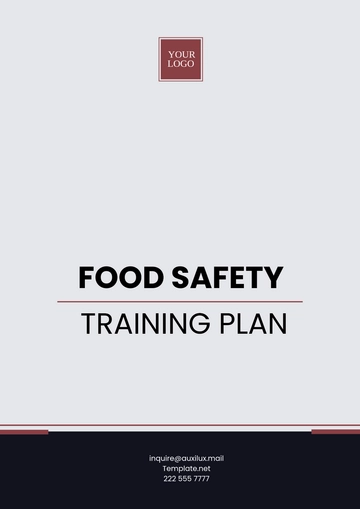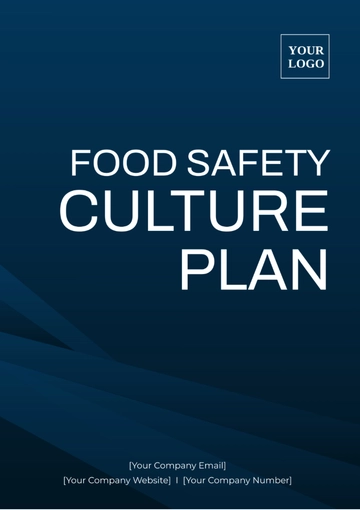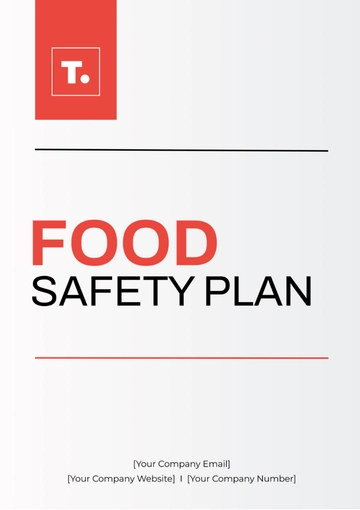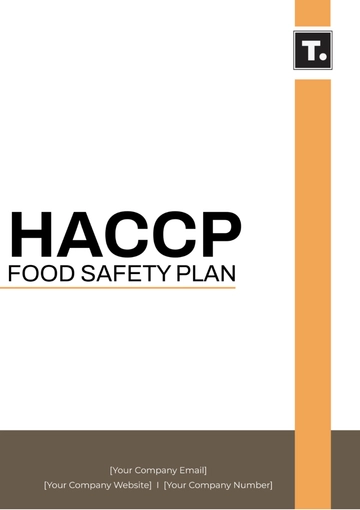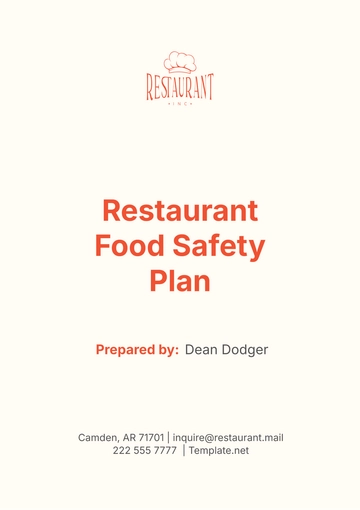Free Restaurant Food Safety Plan
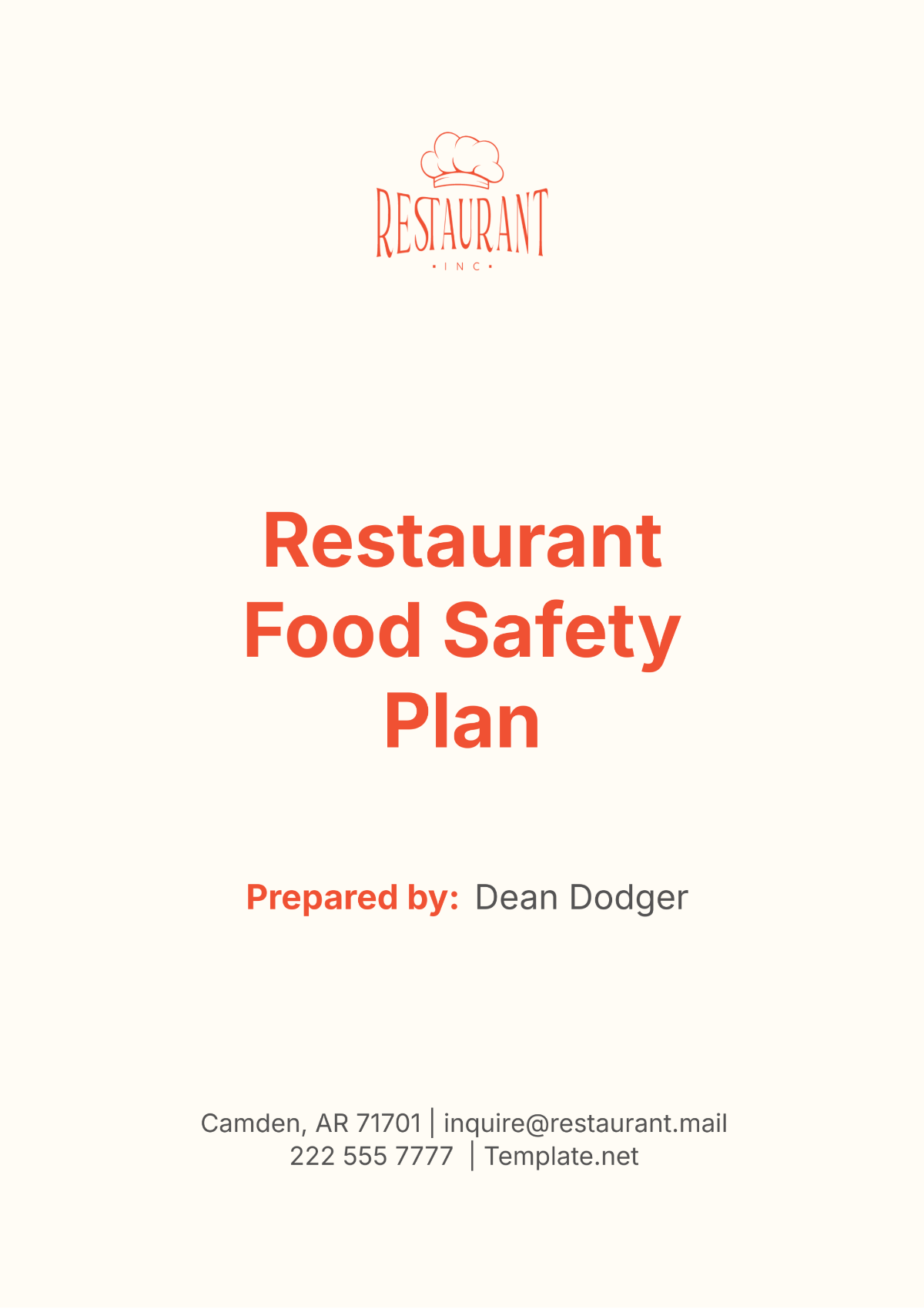
I. Introduction to Food Safety
Ensuring the safety of food served in [Your Company Name] is paramount. This section provides an overview of the foundational principles of food safety, the importance of maintaining high standards, and the role of each employee in achieving these standards. Food safety is not only a regulatory requirement but also a cornerstone of customer trust and business integrity for [Your Company Name]. Compliance with food safety procedures safeguards both patrons and the business's reputation.
This plan outlines specific practices and standards designed to uphold the highest levels of food safety. It includes procedures for handling ingredients, preparation techniques, and guidelines for storing and serving food. By adhering strictly to this plan, [Your Company Name] ensures that all team members are knowledgeable and equipped to manage food safely at every stage of preparation and service.
II. Personal Hygiene & Staff Requirements
Maintaining rigorous personal hygiene standards is essential to prevent foodborne illnesses. The following protocols at [Your Company Name] ensure all staff members adhere to best practices in personal hygiene.
A. Hand Hygiene
Proper handwashing is one of the most effective ways to prevent the spread of pathogens.
1. When to Wash Hands
Before and after handling food.
After using the restroom.
After touching garbage.
After eating, drinking, or smoking.
After handling money.
After touching anything that may contaminate hands, such as cleaning cloths or unclean equipment.
2. How to Wash Hands
Wet hands with warm water.
Apply soap and lather for at least 20 seconds, covering all parts of the hands and wrists.
Rinse hands under running water.
Dry hands using a disposable towel or an air dryer.
B. Uniforms and Protective Garments
Appropriate clothing and hair restraints prevent physical contaminants from entering food.
1. Uniforms
Wear a clean uniform for each shift.
Change uniforms immediately if significantly soiled during a shift.
2. Hair Restraints
Hair must be completely covered with a hairnet or cap.
Beard restraints are required for employees with facial hair.
C. Illness Reporting and Exclusion
Preventing ill staff from working is crucial to safeguard public health.
1. Symptoms Triggering Exclusion
Fever
Vomiting
Diarrhea
Jaundice
Sore throat with fever
Visible infected skin lesions or boils
2. Reporting Protocol
Immediately report symptoms to a supervisor.
Do not return to work until medically cleared.
Follow local health department guidelines regarding notification of contagious diseases.
D. Personal Behavior
Certain behaviors can increase the risk of contaminating food.
1. Prohibited Actions in Food Handling Areas
Eating, drinking, or smoking.
Chewing gum or tobacco.
Using personal electronic devices.
Implementing these standards ensures that all personnel at [Your Company Name] are capable of handling food safely, significantly reducing the risk of contamination and illness.
III. Food Handling Procedures
Correct food handling is vital to prevent contamination and ensure food safety at [Your Company Name]. This section encompasses all the necessary steps involved in the handling of food, from receiving and storing to cooking and serving. Here are the essential steps:

Inspect Deliveries: Verify the quality and temperature of all delivered items to ensure they meet safety standards. Reject any products that show signs of spoilage or improper handling.
Store Appropriately: Organize food by type and store immediately at the correct temperatures. Proper storage prevents bacterial growth and cross-contamination between raw and cooked foods.
Prepare Safely: Wash hands and sanitize all preparation surfaces and tools before and after use. Use designated cutting boards and utensils for different food types to avoid cross-contamination.
Cook Thoroughly: Ensure all foods are cooked to their required internal temperatures to kill harmful bacteria. Always use a calibrated thermometer to check temperatures.
Serve Correctly: Handle food with clean utensils and gloves to maintain hygiene. Ensure that food is served at safe temperatures to prevent bacterial growth.
Clean Regularly: Implement a regular cleaning and sanitizing schedule for all kitchen areas and equipment. Use approved cleaning agents to effectively reduce the risk of contamination.
IV. Cleaning and Sanitation
Maintaining a clean and sanitary environment is paramount at [Your Company Name] to ensure the safety and quality of the food we serve. A systematic approach to cleaning and sanitation helps prevent cross-contamination and adheres to stringent health and safety standards. This section details our protocols for keeping our facilities pristine and safe.
A. Daily Cleaning Routines
Regular cleaning tasks performed on a daily basis to maintain basic hygiene and order in the kitchen.
1. Kitchen Surfaces
Clean all counters, stovetops, and work areas after each use.
Sanitize surfaces with an EPA-approved disinfectant.
2. Equipment Cleaning
Wash pots, pans, utensils, and other equipment immediately after use.
Perform deep cleaning of appliances like grills and ovens daily.
3. Floors and Trash
Sweep and mop kitchen floors at the end of each day.
Empty and sanitize waste bins regularly to avoid odors and pest attraction.
B. Weekly Sanitation Procedures
Intensive cleaning procedures that target areas requiring less frequent, though crucial, maintenance.
1. Refrigerators and Freezers
Clean and sanitize all shelves and interiors weekly to prevent the buildup of residues and bacteria.
Check and organize inventory to ensure no expired items are stored.
2. Deep Cleaning of Storage Areas
Thoroughly clean dry storage and pantry areas to remove dust and debris.
Inspect for any signs of pest infestation and take corrective actions if necessary.
C. Specialized Cleaning Protocols
Procedures for specific situations and how to handle them effectively.
1. Post-Contamination Cleaning
Follow specific protocols for cleaning after identified contamination, such as spills involving raw meat or fish.
Use stronger sanitizers to thoroughly disinfect affected areas.
2. Seasonal Deep Cleans
Conduct comprehensive cleaning of the entire kitchen facility bi-annually, addressing areas not covered in daily or weekly routines.
Include cleaning of ventilation systems, deep freezers, and ceiling fixtures.
V. Emergency Procedures and Food Safety Response
Effective management of food safety emergencies is critical to safeguard consumer health and preserve the integrity of [Your Company Name]. This section outlines a structured response plan for incidents such as foodborne illness outbreaks and contamination. Swift action, clear communication, and detailed protocols are essential to manage these situations effectively, minimizing harm and legal repercussions.

Identify and Assess: Quickly identify the issue and assess the scope and potential impact of the emergency on food safety.
Isolate the Problem: Immediately isolate the affected product or area to prevent further contamination or exposure.
Notify Supervisors: Report the incident to the designated supervisor or food safety officer without delay.
Contact Health Authorities: Notify local health authorities to report the incident and seek guidance on further actions.
Implement Corrective Actions: Follow the pre-defined corrective actions specific to the type of incident, such as disposing of contaminated food or sanitizing affected areas.
Document and Review: Record all details of the incident and the response actions taken. Review the situation to improve future response plans and prevent recurrence.
These steps ensure a rapid and effective response to any food safety incident, helping to control the situation and mitigate its impact on both consumers and the business.
- 100% Customizable, free editor
- Access 1 Million+ Templates, photo’s & graphics
- Download or share as a template
- Click and replace photos, graphics, text, backgrounds
- Resize, crop, AI write & more
- Access advanced editor
Ensure food safety compliance effortlessly with the Restaurant Food Safety Plan Template from Template.net. This editable and customizable document simplifies creating comprehensive food safety plans for your restaurant. Tailored for the food industry, it's editable in our Ai Editor Tool, ensuring seamless customization to meet your restaurant's specific needs.
You may also like
- Finance Plan
- Construction Plan
- Sales Plan
- Development Plan
- Career Plan
- Budget Plan
- HR Plan
- Education Plan
- Transition Plan
- Work Plan
- Training Plan
- Communication Plan
- Operation Plan
- Health And Safety Plan
- Strategy Plan
- Professional Development Plan
- Advertising Plan
- Risk Management Plan
- Restaurant Plan
- School Plan
- Nursing Home Patient Care Plan
- Nursing Care Plan
- Plan Event
- Startup Plan
- Social Media Plan
- Staffing Plan
- Annual Plan
- Content Plan
- Payment Plan
- Implementation Plan
- Hotel Plan
- Workout Plan
- Accounting Plan
- Campaign Plan
- Essay Plan
- 30 60 90 Day Plan
- Research Plan
- Recruitment Plan
- 90 Day Plan
- Quarterly Plan
- Emergency Plan
- 5 Year Plan
- Gym Plan
- Personal Plan
- IT and Software Plan
- Treatment Plan
- Real Estate Plan
- Law Firm Plan
- Healthcare Plan
- Improvement Plan
- Media Plan
- 5 Year Business Plan
- Learning Plan
- Marketing Campaign Plan
- Travel Agency Plan
- Cleaning Services Plan
- Interior Design Plan
- Performance Plan
- PR Plan
- Birth Plan
- Life Plan
- SEO Plan
- Disaster Recovery Plan
- Continuity Plan
- Launch Plan
- Legal Plan
- Behavior Plan
- Performance Improvement Plan
- Salon Plan
- Security Plan
- Security Management Plan
- Employee Development Plan
- Quality Plan
- Service Improvement Plan
- Growth Plan
- Incident Response Plan
- Basketball Plan
- Emergency Action Plan
- Product Launch Plan
- Spa Plan
- Employee Training Plan
- Data Analysis Plan
- Employee Action Plan
- Territory Plan
- Audit Plan
- Classroom Plan
- Activity Plan
- Parenting Plan
- Care Plan
- Project Execution Plan
- Exercise Plan
- Internship Plan
- Software Development Plan
- Continuous Improvement Plan
- Leave Plan
- 90 Day Sales Plan
- Advertising Agency Plan
- Employee Transition Plan
- Smart Action Plan
- Workplace Safety Plan
- Behavior Change Plan
- Contingency Plan
- Continuity of Operations Plan
- Health Plan
- Quality Control Plan
- Self Plan
- Sports Development Plan
- Change Management Plan
- Ecommerce Plan
- Personal Financial Plan
- Process Improvement Plan
- 30-60-90 Day Sales Plan
- Crisis Management Plan
- Engagement Plan
- Execution Plan
- Pandemic Plan
- Quality Assurance Plan
- Service Continuity Plan
- Agile Project Plan
- Fundraising Plan
- Job Transition Plan
- Asset Maintenance Plan
- Maintenance Plan
- Software Test Plan
- Staff Training and Development Plan
- 3 Year Plan
- Brand Activation Plan
- Release Plan
- Resource Plan
- Risk Mitigation Plan
- Teacher Plan
- 30 60 90 Day Plan for New Manager
- Food Safety Plan
- Food Truck Plan
- Hiring Plan
- Quality Management Plan
- Wellness Plan
- Behavior Intervention Plan
- Bonus Plan
- Investment Plan
- Maternity Leave Plan
- Pandemic Response Plan
- Succession Planning
- Coaching Plan
- Configuration Management Plan
- Remote Work Plan
- Self Care Plan
- Teaching Plan
- 100-Day Plan
- HACCP Plan
- Student Plan
- Sustainability Plan
- 30 60 90 Day Plan for Interview
- Access Plan
- Site Specific Safety Plan
